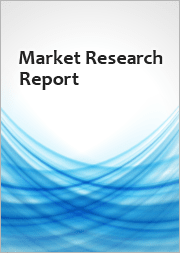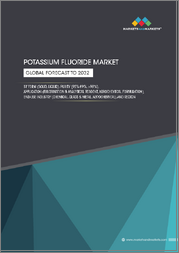
|
시장보고서
상품코드
1719249
세계의 불화 리튬 시장 : 산업 규모, 점유율, 동향, 기회, 예측 - 판매채널별, 최종 용도별, 지역별, 경쟁별(2020-2030년)Lithium Fluoride Market - Global Industry Size, Share, Trends, Opportunity, and Forecast, Segmented By Sales Channel, By End Use, By Region and Competition, 2020-2030F |
||||||
불화리튬 세계 시장은 2024년에는 44억 3,885만 달러로 2030년에는 69억 8,373만 달러에 달할 것으로 예상되며, 예측 기간 동안 3.86%의 연평균 복합 성장률(CAGR)을 보일 것으로 예측됩니다.
주요 리튬 화합물인 불화리튬(LiF)은 높은 융점, 열 안정성, 뛰어난 내화학성으로 인해 다양한 산업에서 필수적인 요소로 각광받고 있습니다. 수요는 원자력 기술, 에너지 저장, 산업 공정의 발전에 의해 촉진되고 있습니다. 미국 지질조사국(USGS)의 데이터에 따르면, 세계 리튬 공급의 대부분은 호주와 중국의 경질 암석 채굴이 각각 49%와 17%를 차지합니다. 청정 에너지에 대한 노력과 원자로 기술 혁신이 가속화됨에 따라 불화 리튬에 대한 수요가 증가하고 있습니다. 그러나 시장 성장은 원료 공급 리스크와 다양하고 지속 가능한 조달의 필요성에 의해 억제되고 있습니다.
| 시장 개요 | |
|---|---|
| 예측 기간 | 2026-2030년 |
| 시장 규모 : 2024년 | 44억 3,885만 달러 |
| 시장 규모 : 2030년 | 69억 8,373만 달러 |
| CAGR : 2025-2030년 | 3.86% |
| 급성장 부문 | 간접 |
| 최대 시장 | 아시아태평양 |
주요 시장 성장 촉진요인
리튬 배터리 제조에 불화리튬 사용 확대
주요 시장 과제
제한된 원자재 가용성
주요 시장 동향
원자력 기술의 발전
목차
제1장 제품 개요
제2장 조사 방법
제3장 주요 요약
제4장 세계의 불화 리튬 시장에 대한 COVID-19의 영향
제5장 세계의 불화 리튬 시장 전망
- 시장 규모와 예측
- 금액별
- 시장 점유율과 예측
- 판매채널별(직접, 간접)
- 최종 용도별(리튬 배터리, 세라믹 및 유리, 원자로, 광학 재료, 기타)
- 지역별
- 기업별(2024년)
- 시장 맵
제6장 북미의 불화 리튬 시장 전망
- 시장 규모와 예측
- 시장 점유율과 예측
- 북미 : 국가별 분석
- 미국
- 멕시코
- 캐나다
제7장 유럽의 불화 리튬 시장 전망
- 시장 규모와 예측
- 시장 점유율과 예측
- 유럽 : 국가별 분석
- 프랑스
- 독일
- 영국
- 이탈리아
- 스페인
제8장 아시아태평양의 불화 리튬 시장 전망
- 시장 규모와 예측
- 시장 점유율과 예측
- 아시아태평양 : 국가별 분석
- 중국
- 인도
- 한국
- 일본
- 호주
제9장 남미의 불화 리튬 시장 전망
- 시장 규모와 예측
- 시장 점유율과 예측
- 남미 : 국가별 분석
- 브라질
- 아르헨티나
- 콜롬비아
제10장 중동 및 아프리카의 불화 리튬 시장 전망
- 시장 규모와 예측
- 시장 점유율과 예측
- 중동 및 아프리카 : 국가별 분석
- 남아프리카공화국
- 사우디아라비아
- 아랍에미리트(UAE)
제11장 시장 역학
- 성장 촉진요인
- 과제
제12장 시장 동향과 발전
- 인수합병(M&A)
- 제품 출시
- 최근 동향
제13장 세계의 불화 리튬 시장 : SWOT 분석
제14장 Porter의 Five Forces 분석
- 업계내 경쟁
- 신규 참여 가능성
- 공급업체의 힘
- 고객의 힘
- 대체품의 위협
제15장 경쟁 구도
- Anhui Fitech Materials Co., Ltd
- Shandong Yinglang Chemical Co.,Ltd
- Hubei Baijierui Advanced Materials Co., Ltd
- Tinci Materials Technology Co., Ltd
- Baiyin Zhongtian Co Ltd
- Jiangxi Dongpeng New Materials Co., Ltd
- Shandong Lingkai Pharmaceuticals Co Ltd.
- Ganzhou Songhui New Fluorine Material Co., Ltd
- Taixing Best New Materials Co., Ltd
- Dofluoropoly Chemical Co., Ltd
제16장 전략적 제안
제17장 회사 소개 및 면책조항
LSH 25.05.22The Global Lithium Fluoride Market was valued at USD 4,438.85 Million in 2024 and is projected to reach USD 6,983.73 Million by 2030, growing at a CAGR of 3.86% during the forecast period. Lithium fluoride (LiF), a key lithium compound, is gaining increased traction due to its high melting point, thermal stability, and exceptional chemical resistance, making it indispensable across several industries. Demand is being propelled by advancements in nuclear technology, energy storage, and industrial processes. According to data from the United States Geological Survey (USGS), most global lithium supply stems from hard rock mining in Australia and China, contributing 49% and 17% respectively, while lithium-rich brines in Chile and Argentina provide 22% and 8%. As clean energy initiatives and nuclear reactor innovations accelerate, the need for lithium fluoride is growing. However, market growth is tempered by raw material supply risks and the need for diversified and sustainable sourcing.
| Market Overview | |
|---|---|
| Forecast Period | 2026-2030 |
| Market Size 2024 | USD 4,438.85 Million |
| Market Size 2030 | USD 6,983.73 Million |
| CAGR 2025-2030 | 3.86% |
| Fastest Growing Segment | Indirect |
| Largest Market | Asia Pacific |
Key Market Drivers
Growing Use of Lithium Fluoride in Making Lithium Batteries
The increasing adoption of lithium fluoride in lithium-ion battery production is a major driver of the market. LiF is critical in the development of solid-state electrolytes that outperform conventional liquid electrolytes in terms of energy density, thermal stability, and safety. Advancements in battery technologies, including fluoride-based batteries previously limited to high-temperature conditions, now allow room-temperature applications, expanding the scope of usage. Notably, lithium's electropositive nature complements fluoride's electronegativity, making their combination highly suitable for stable electrochemical performance. In 2023, researchers at Argonne National Laboratory introduced a novel electrolyte for lithium metal batteries used in electric vehicles, improving range, reducing costs, and enhancing safety. As electric mobility and renewable energy storage infrastructure continue to grow, lithium fluoride's role in advanced battery systems is expected to expand significantly.
Key Market Challenges
Limited Raw Material Availability
The concentration of lithium reserves in a limited number of countries-primarily Australia, Chile, Argentina, and China-poses a considerable supply risk for the lithium fluoride market. This geographical limitation exposes global supply chains to geopolitical tensions, trade policies, and resource nationalism. Disruptions in lithium mining or export from any of these key producers can result in significant market volatility. Moreover, environmental concerns related to lithium extraction-such as water consumption, land disruption, and chemical runoff-have led to stricter regulations and delays in mining approvals, increasing production costs and impeding supply growth. These factors present a major challenge to the scalability and sustainability of lithium fluoride supply in the years ahead.
Key Market Trends
Advancements in Nuclear Energy Technologies
The revival of molten salt reactor (MSR) technology is emerging as a transformative trend in the lithium fluoride market. MSRs, which use mixtures of lithium fluoride and other fluorides as both coolants and fuel solvents, offer enhanced efficiency, superior safety features, and low operating pressures compared to traditional reactors. The high thermal conductivity and chemical resilience of lithium fluoride make it an ideal candidate for use in such advanced reactor designs. Governments and private enterprises in countries including the U.S., China, and Canada are heavily investing in MSR development and pilot projects, increasing the demand for lithium fluoride. These reactors are pivotal to the future of clean nuclear energy, further cementing lithium fluoride's strategic importance in energy transition initiatives.
Key Market Players
- Anhui Fitech Materials Co., Ltd
- Shandong Yinglang Chemical Co., Ltd
- Hubei Baijierui Advanced Materials Co., Ltd
- Tinci Materials Technology Co., Ltd
- Baiyin Zhongtian Co. Ltd
- Jiangxi Dongpeng New Materials Co., Ltd
- Shandong Lingkai Pharmaceuticals Co. Ltd
- Ganzhou Songhui New Fluorine Material Co., Ltd
- Taixing Best New Materials Co., Ltd
- Dofluoropoly Chemical Co., Ltd
Report Scope
In this report, the Global Lithium Fluoride Market has been segmented into the following categories, in addition to the industry trends which have also been detailed below:
Lithium Fluoride Market, By Sales Channel:
- Direct
- Indirect
Lithium Fluoride Market, By End Use:
- Lithium Batteries
- Ceramics & Glass
- Nuclear Reactors
- Optical Material
- Others
Lithium Fluoride Market, By Region:
- North America
- United States
- Canada
- Mexico
- Europe
- France
- United Kingdom
- Italy
- Germany
- Spain
- Asia Pacific
- China
- India
- Japan
- Australia
- South Korea
- South America
- Brazil
- Argentina
- Colombia
- Middle East & Africa
- South Africa
- Saudi Arabia
- UAE
Competitive Landscape
Company Profiles: Detailed analysis of the major companies present in the Global Lithium Fluoride Market.
Available Customizations
Global Lithium Fluoride Market report with the given market data, TechSci Research offers customizations according to a company's specific needs. The following customization options are available for the report:
Company Information
- Detailed analysis and profiling of additional market players (up to five).
Table of Contents
1. Product Overview
- 1.1. Market Definition
- 1.2. Scope of the Market
- 1.2.1. Markets Covered
- 1.2.2. Years Considered for Study
- 1.2.3. Key Market Segmentations
2. Research Methodology
- 2.1. Objective of the Study
- 2.2. Baseline Methodology
- 2.3. Key Industry Partners
- 2.4. Major Association and Secondary Sources
- 2.5. Forecasting Methodology
- 2.6. Data Triangulation & Validation
- 2.7. Assumptions and Limitations
3. Executive Summary
- 3.1. Overview of the Market
- 3.2. Overview of Key Market Segmentations
- 3.3. Overview of Key Market Players
- 3.4. Overview of Key Regions/Countries
- 3.5. Overview of Market Drivers, Challenges, and Trends
4. Impact of COVID-19 on Global Lithium Fluoride Market
5. Global Lithium Fluoride Market Outlook
- 5.1. Market Size & Forecast
- 5.1.1. By Value
- 5.2. Market Share & Forecast
- 5.2.1. By Sales Channel (Direct, Indirect)
- 5.2.2. By End Use (Lithium Batteries, Ceramics & Glass, Nuclear Reactors, Optical Material, Others)
- 5.2.3. By Region
- 5.2.4. By Company (2024)
- 5.3. Market Map
6. North America Lithium Fluoride Market Outlook
- 6.1. Market Size & Forecast
- 6.1.1. By Value
- 6.2. Market Share & Forecast
- 6.2.1. By Sales Channel
- 6.2.2. By End Use
- 6.2.3. By Country
- 6.3. North America: Country Analysis
- 6.3.1. United States Lithium Fluoride Market Outlook
- 6.3.1.1. Market Size & Forecast
- 6.3.1.1.1. By Value
- 6.3.1.2. Market Share & Forecast
- 6.3.1.2.1. By Sales Channel
- 6.3.1.2.2. By End Use
- 6.3.1.1. Market Size & Forecast
- 6.3.2. Mexico Lithium Fluoride Market Outlook
- 6.3.2.1. Market Size & Forecast
- 6.3.2.1.1. By Value
- 6.3.2.2. Market Share & Forecast
- 6.3.2.2.1. By Sales Channel
- 6.3.2.2.2. By End Use
- 6.3.2.1. Market Size & Forecast
- 6.3.3. Canada Lithium Fluoride Market Outlook
- 6.3.3.1. Market Size & Forecast
- 6.3.3.1.1. By Value
- 6.3.3.2. Market Share & Forecast
- 6.3.3.2.1. By Sales Channel
- 6.3.3.2.2. By End Use
- 6.3.3.1. Market Size & Forecast
- 6.3.1. United States Lithium Fluoride Market Outlook
7. Europe Lithium Fluoride Market Outlook
- 7.1. Market Size & Forecast
- 7.1.1. By Value
- 7.2. Market Share & Forecast
- 7.2.1. By Sales Channel
- 7.2.2. By End Use
- 7.2.3. By Country
- 7.3. Europe: Country Analysis
- 7.3.1. France Lithium Fluoride Market Outlook
- 7.3.1.1. Market Size & Forecast
- 7.3.1.1.1. By Value
- 7.3.1.2. Market Share & Forecast
- 7.3.1.2.1. By Sales Channel
- 7.3.1.2.2. By End Use
- 7.3.1.1. Market Size & Forecast
- 7.3.2. Germany Lithium Fluoride Market Outlook
- 7.3.2.1. Market Size & Forecast
- 7.3.2.1.1. By Value
- 7.3.2.2. Market Share & Forecast
- 7.3.2.2.1. By Sales Channel
- 7.3.2.2.2. By End Use
- 7.3.2.1. Market Size & Forecast
- 7.3.3. United Kingdom Lithium Fluoride Market Outlook
- 7.3.3.1. Market Size & Forecast
- 7.3.3.1.1. By Value
- 7.3.3.2. Market Share & Forecast
- 7.3.3.2.1. By Sales Channel
- 7.3.3.2.2. By End Use
- 7.3.3.1. Market Size & Forecast
- 7.3.4. Italy Lithium Fluoride Market Outlook
- 7.3.4.1. Market Size & Forecast
- 7.3.4.1.1. By Value
- 7.3.4.2. Market Share & Forecast
- 7.3.4.2.1. By Sales Channel
- 7.3.4.2.2. By End Use
- 7.3.4.1. Market Size & Forecast
- 7.3.5. Spain Lithium Fluoride Market Outlook
- 7.3.5.1. Market Size & Forecast
- 7.3.5.1.1. By Value
- 7.3.5.2. Market Share & Forecast
- 7.3.5.2.1. By Sales Channel
- 7.3.5.2.2. By End Use
- 7.3.5.1. Market Size & Forecast
- 7.3.1. France Lithium Fluoride Market Outlook
8. Asia Pacific Lithium Fluoride Market Outlook
- 8.1. Market Size & Forecast
- 8.1.1. By Value
- 8.2. Market Share & Forecast
- 8.2.1. By Sales Channel
- 8.2.2. By End Use
- 8.2.3. By Country
- 8.3. Asia Pacific: Country Analysis
- 8.3.1. China Lithium Fluoride Market Outlook
- 8.3.1.1. Market Size & Forecast
- 8.3.1.1.1. By Value
- 8.3.1.2. Market Share & Forecast
- 8.3.1.2.1. By Sales Channel
- 8.3.1.2.2. By End Use
- 8.3.1.1. Market Size & Forecast
- 8.3.2. India Lithium Fluoride Market Outlook
- 8.3.2.1. Market Size & Forecast
- 8.3.2.1.1. By Value
- 8.3.2.2. Market Share & Forecast
- 8.3.2.2.1. By Sales Channel
- 8.3.2.2.2. By End Use
- 8.3.2.1. Market Size & Forecast
- 8.3.3. South Korea Lithium Fluoride Market Outlook
- 8.3.3.1. Market Size & Forecast
- 8.3.3.1.1. By Value
- 8.3.3.2. Market Share & Forecast
- 8.3.3.2.1. By Sales Channel
- 8.3.3.2.2. By End Use
- 8.3.3.1. Market Size & Forecast
- 8.3.4. Japan Lithium Fluoride Market Outlook
- 8.3.4.1. Market Size & Forecast
- 8.3.4.1.1. By Value
- 8.3.4.2. Market Share & Forecast
- 8.3.4.2.1. By Sales Channel
- 8.3.4.2.2. By End Use
- 8.3.4.1. Market Size & Forecast
- 8.3.5. Australia Lithium Fluoride Market Outlook
- 8.3.5.1. Market Size & Forecast
- 8.3.5.1.1. By Value
- 8.3.5.2. Market Share & Forecast
- 8.3.5.2.1. By Sales Channel
- 8.3.5.2.2. By End Use
- 8.3.5.1. Market Size & Forecast
- 8.3.1. China Lithium Fluoride Market Outlook
9. South America Lithium Fluoride Market Outlook
- 9.1. Market Size & Forecast
- 9.1.1. By Value
- 9.2. Market Share & Forecast
- 9.2.1. By Sales Channel
- 9.2.2. By End Use
- 9.2.3. By Country
- 9.3. South America: Country Analysis
- 9.3.1. Brazil Lithium Fluoride Market Outlook
- 9.3.1.1. Market Size & Forecast
- 9.3.1.1.1. By Value
- 9.3.1.2. Market Share & Forecast
- 9.3.1.2.1. By Sales Channel
- 9.3.1.2.2. By End Use
- 9.3.1.1. Market Size & Forecast
- 9.3.2. Argentina Lithium Fluoride Market Outlook
- 9.3.2.1. Market Size & Forecast
- 9.3.2.1.1. By Value
- 9.3.2.2. Market Share & Forecast
- 9.3.2.2.1. By Sales Channel
- 9.3.2.2.2. By End Use
- 9.3.2.1. Market Size & Forecast
- 9.3.3. Colombia Lithium Fluoride Market Outlook
- 9.3.3.1. Market Size & Forecast
- 9.3.3.1.1. By Value
- 9.3.3.2. Market Share & Forecast
- 9.3.3.2.1. By Sales Channel
- 9.3.3.2.2. By End Use
- 9.3.3.1. Market Size & Forecast
- 9.3.1. Brazil Lithium Fluoride Market Outlook
10. Middle East and Africa Lithium Fluoride Market Outlook
- 10.1. Market Size & Forecast
- 10.1.1. By Value
- 10.2. Market Share & Forecast
- 10.2.1. By Sales Channel
- 10.2.2. By End Use
- 10.2.3. By Country
- 10.3. MEA: Country Analysis
- 10.3.1. South Africa Lithium Fluoride Market Outlook
- 10.3.1.1. Market Size & Forecast
- 10.3.1.1.1. By Value
- 10.3.1.2. Market Share & Forecast
- 10.3.1.2.1. By Sales Channel
- 10.3.1.2.2. By End Use
- 10.3.1.1. Market Size & Forecast
- 10.3.2. Saudi Arabia Lithium Fluoride Market Outlook
- 10.3.2.1. Market Size & Forecast
- 10.3.2.1.1. By Value
- 10.3.2.2. Market Share & Forecast
- 10.3.2.2.1. By Sales Channel
- 10.3.2.2.2. By End Use
- 10.3.2.1. Market Size & Forecast
- 10.3.3. UAE Lithium Fluoride Market Outlook
- 10.3.3.1. Market Size & Forecast
- 10.3.3.1.1. By Value
- 10.3.3.2. Market Share & Forecast
- 10.3.3.2.1. By Sales Channel
- 10.3.3.2.2. By End Use
- 10.3.3.1. Market Size & Forecast
- 10.3.1. South Africa Lithium Fluoride Market Outlook
11. Market Dynamics
- 11.1. Drivers
- 11.2. Challenges
12. Market Trends & Developments
- 12.1. Merger & Acquisition (If Any)
- 12.2. Product Launches (If Any)
- 12.3. Recent Developments
13. Global Lithium Fluoride Market: SWOT Analysis
14. Porters Five Forces Analysis
- 14.1. Competition in the Industry
- 14.2. Potential of New Entrants
- 14.3. Power of Suppliers
- 14.4. Power of Customers
- 14.5. Threat of Substitute Products
15. Competitive Landscape
- 15.1. Anhui Fitech Materials Co., Ltd
- 15.1.1. Business Overview
- 15.1.2. Company Snapshot
- 15.1.3. Products & Services
- 15.1.4. Financials (As Reported)
- 15.1.5. Recent Developments
- 15.1.6. Key Personnel Details
- 15.1.7. SWOT Analysis
- 15.2. Shandong Yinglang Chemical Co.,Ltd
- 15.3. Hubei Baijierui Advanced Materials Co., Ltd
- 15.4. Tinci Materials Technology Co., Ltd
- 15.5. Baiyin Zhongtian Co Ltd
- 15.6. Jiangxi Dongpeng New Materials Co., Ltd
- 15.7. Shandong Lingkai Pharmaceuticals Co Ltd.
- 15.8. Ganzhou Songhui New Fluorine Material Co., Ltd
- 15.9. Taixing Best New Materials Co., Ltd
- 15.10. Dofluoropoly Chemical Co., Ltd
16. Strategic Recommendations
17. About Us & Disclaimer
(주말 및 공휴일 제외)


















